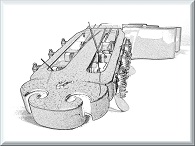Welcome to one of the most active flamenco sites on the Internet. Guests can read most posts but if you want to participate click here to register.
This site is dedicated to the memory of Paco de Lucía, Ron Mitchell, Guy Williams, Linda Elvira, Philip John Lee, Craig Eros, Ben Woods, David Serva and Tom Blackshear who went ahead of us.
We receive 12,200 visitors a month from 200 countries and 1.7 million page impressions a year. To advertise on this site please contact us.
|

|
|
The Leonardo Project: Back and Sides wood Blind tested
|
You are logged in as Guest
|
|
Users viewing this topic: none
|
|
Login  | |
|

   
estebanana
Posts: 9351
Joined: Oct. 16 2009

|
 RE: The Leonardo Project: Back and S... (in reply to hamia) RE: The Leonardo Project: Back and S... (in reply to hamia)
|
|
|
quote:
I don't think light and less dense materials are good for back and sides - in fact exactly the opposite. The soundboard is what vibrates to give the sound - any vibrations from the back and sides will interfere with this vibration. The ideal case is if the back and sides are so dense that they don't vibrate at all. In which case the sound wave is perfectly reflected from the back and only the top vibrates. Brazilian rosewood is favoured because it is dense and looks nice but I think a suitable plywood or composite material would be just as good.
There are two main schools of thought on backs and side and what they do. The idea that the back be should dense and thick and that the sides should be rigid and stiff around the rim is only one outlook on this system. Guitars like Greg Smallman's design depend on everything but the top to be heavily reinforced and fairly inert allowing only the top to be in action. Other ideas work very well too, for example the classic Spanish flamenco designs, Santos, Barbero, Rodriguez, etc. are built so the guitar vibrates and these designs operate and produce that sound in part because everything is moving together. Those guitars would sound really different with heavy inert backs and sides that gave no play. They would sound more like grand pianos or harps or banjos, not flamenco guitars.
Back and sides vibrations don't prevent the top from working, unless they are acoustically coupled in a negative way- if they have a close main modal coupling. Like if the back and top share a main mode tuning note like A, the coupling between the back and top can cause a lot of problems due to, among other things, out of sync phase shifting. If the back and top are not poorly acoustically coupled the back can be stiff and dense and fairly inert or it can be somewhat lively and active, both ways the back will work. The thing is that they should never be acoustically coupled.
There is fact sound coming off of the neck, headstock and sides of a guitar, and to some extent the back if it is not muffled by the player. These are facts that have been laboratory proven by acoustical testing.
The real idea in guitar making is not a game of extremes, but to make compromises to arrive at good solutions to many problems at one time. That is why the best designs of the Spanish makers have endured as good design that produces good sound. Those designs are not extreme. And on the other end of the spectrum with newer designs like nomex tops and lattice bracing etc. those designs are also arrived at by a give and take approach where each problem is mounted and over come by small measures at a time.
The density of materials is also a game of median line selection. Too dense and there are problems, not enough density and mass and there are other problems. Speaking for flamenco guitars, the best instruments are not far into the lighter weight range or far into the stiffer denser range, they are all in the middle somewhere. The way each maker handles and juggles a set of parameters which are median in range is where the game remains.
Theoretically there is a lot of stuff that can be learned by making instruments that challenge the borders of the extremes, but it's like there so much to learn simply by building good guitars in the middle of ultra stiff and dense vs. feather light why bother to go to extremes?
________________
Papier Mache in Torres' time was a common material to make hat boxes and decorative black lacquer serving trays. The kind that might have been in your grandmas house in the 1960's left over from her mothers or grandmothers stuff. The papier mache of that era was similar to untempered masonite of our day, was often molded or pressed under pressure to form utilitarian objects. The stuff Torres used was pretty stiff and much like a thin sheet of masonite. The material is not super fragile, maybe brittle today, but as I have understood it the papier mache material was hard a stiff, like tough stiff cardboard or plywood.
___________________________________
_____________________________
https://www.stephenfaulkguitars.com
|
|
|
|
REPORT THIS POST AS INAPPROPRIATE |
Date Feb. 2 2016 14:03:14
 |
|
 New Messages New Messages |
 No New Messages No New Messages |
 Hot Topic w/ New Messages Hot Topic w/ New Messages |
 Hot Topic w/o New Messages Hot Topic w/o New Messages |
 Locked w/ New Messages Locked w/ New Messages |
 Locked w/o New Messages Locked w/o New Messages |
|
 Post New Thread
Post New Thread
 Reply to Message
Reply to Message
 Post New Poll
Post New Poll
 Submit Vote
Submit Vote
 Delete My Own Post
Delete My Own Post
 Delete My Own Thread
Delete My Own Thread
 Rate Posts
Rate Posts
|
|
|
Forum Software powered by ASP Playground Advanced Edition 2.0.5
Copyright © 2000 - 2003 ASPPlayground.NET |
0.078125 secs.
|


 Printable Version
Printable Version









 New Messages
New Messages No New Messages
No New Messages Hot Topic w/ New Messages
Hot Topic w/ New Messages Hot Topic w/o New Messages
Hot Topic w/o New Messages Locked w/ New Messages
Locked w/ New Messages Locked w/o New Messages
Locked w/o New Messages Post New Thread
Post New Thread